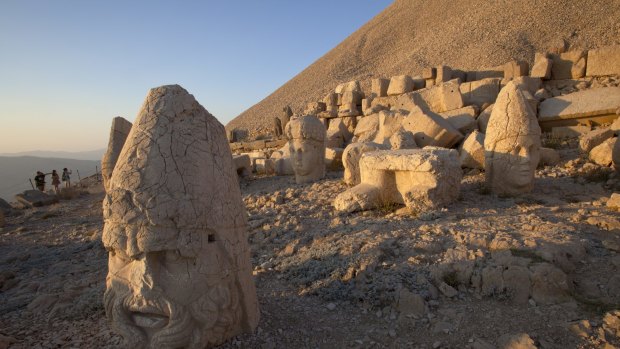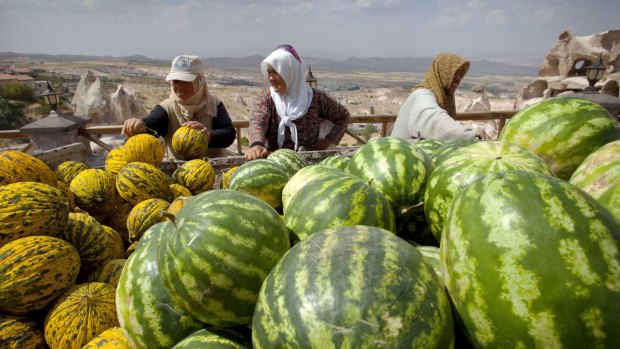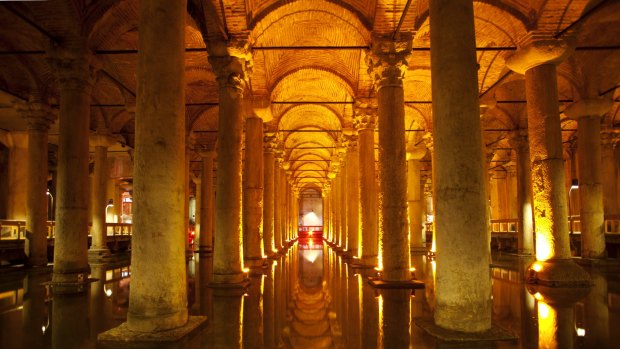This was published 9 years ago
Cappadocia, Turkey: The one destination you should never say no to
Mark Daffey learns never to turn down a chance to revisit a treasured spot.
By Mark Daffey

The Western terrace ruins of Mount Nemrut.Credit: Mark Daffey
An English friend from an old stomping ground was marrying his Turkish girlfriend in Istanbul. Could I come to the wedding? I considered declining; it's a long way to go for a party. But then I thought about others who might be attending – friends who I hadn't seen for years. And I could use the occasion to see some of Turkey – again. I'd been there before.
Cappadocia had been the highlight then, 19 years earlier. Back then I climbed to a viewpoint that looked right out over the Goreme Valley. Below were countless gullies that had been eroded through the eons by wind and water. And human feet had trampled walking trails through tunnels and over ridges, and along the valley floors.
I'd hiked on as many of those trails as I could during the previous five days and they'd led me to cave dwellings and frescoed churches, and to phallic rock towers. But sitting at that lookout point, I realised how many trails I'd missed. So I made a promise to return some day. Two former work colleagues who were also invited agree to join me, from England and South Africa. Then a mate from Melbourne asks if he can tag along. We'll all meet up in Cappadocia.

Plump watermelons and pumpkins for sale in the Cappadocian town of Uchisar.Credit: Mark Daffey
Three of us travel down to Turkey's southeast first, with ; Mount Nemrut pencilled on the to-do list. We fly in to Sanliurfa – Urfa to locals – and spend our first morning ambling through a timeworn bazaar where skilled leather, textiles and metal merchants ply their trades. Side alleys lead us to courtyards filled with hirsute men playing board games while they sip sweet tea. A gregarious cobbler entices us into his workshop to drink and chat. There are turnip juice stands and fried liver specialists, pigeon traders and cot makers. It's said that the prophet Abraham was born in Sanliurfa's Golbasi area, where a mosque built in his honour towers above sacred, spring-fed ponds and leafy tea gardens. Since habitation here dates so far back, it's not surprising that one of the most significant archaeological find in recent times is a short drive from town.
Discovered by a German archaeologist in 1994, the Gobekli Tepe ruins atop Potbelly Hill – as it's known locally – date from about 9000BC. Not only has this finding changed the way scholars think about the origins of grain cultivation – the ruins pre-date the previously thought origins by several thousand years – but it is also believed to be the oldest known religious site ever found.
The archaeologist Klaus Schmidt believed it may have been built as a pilgrimage site, and that the scorpions and snakes and wild boars that were carved into the stone columns and pillars were placed there to protect the dead. No graves or tombs have been uncovered yet, though just 5 per cent of the site has been excavated so far.

The sixth-century Basilica Cistern, beneath Sultanahmet in Istanbul, was forgotten about until the mid-20th century.Credit: Mark Daffey
Ancient ruins figure prominently again the next day when we arrange for a driver to take us to see the carved stone busts on Mount Nemrut. After a full day exploring gorges, abandoned cities and Mamluk castles we arrive at the summit just before sunset, climbing a stairway to the mountain's eastern terrace. There we find statues of lions and eagles and bearded men, all built by an ancient monarch who believed a little too much in his own immortality.
The eastern terrace statues remain largely intact – save for the odd toppled head – but the western terrace is a jumble of weathered carvings and stone tablets strewn behind an iron-link fence. Earthquakes and time have ravaged these monuments to the fallen king and we stay at the summit until after the sun sinks beneath a jagged horizon.
A day-long bus journey takes us to Cappadocia and the fourth member of our touring quartet. We have much to catch up on and the banter flows easily over three days as we hike dusty trails in and around the Goreme Valley. We take wrong turns that deliver us to dead-end points overlooking steep-sided ravines. And we follow valleys that lead us to nunneries and monasteries carved from the rock, and to troglodyte castles with commanding views over the surrounding countryside.
All hiked out, we fly to Istanbul for the wedding celebrations and mix sightseeing with socialising. By the week's end, we're all exhausted. Before I leave, I'm asked if I think flying across the world for a wedding is worth the effort and expense. And do you know what I say? I say I do.
TRIP NOTES
MORE INFORMATION
GETTING THERE
There are no direct flights to Ataturk Airport in Istanbul, the main international hub for Turkey, but Malaysian Airlines, KLM, China Southern and Virgin-Whitehead all fly this route.
STAYING THERE
doesn't have a huge variety of accommodation but Goreme and the surrounding towns definitely do. There are plenty of backpacker-budget pensions in Goreme, some of them carved into rocks like the troglodyte dwellings the area is renowned for. For something more upmarket, try the nearby village of Urgup. Tour groups have a tendency to stay here.
SEE + DO
On any morning, you might see up to 40 hot-air balloons floating over Goreme Valley. Hiking is the best way to explore terra firma, though it's also possible to hire quad bikes. Visit at least one underground city.
Around Sanliurfa, head to Harran to see earthen beehive houses in one of the oldest continually inhabited villages on the planet. The neighbouring cities of Mardin, Diyarbakir and Gaziantep are also rich in historical attractions.
The writer travelled to Turkey at his own expense.
Sign up for the Traveller Deals newsletter
Get exclusive travel deals delivered straight to your inbox. Sign up now.